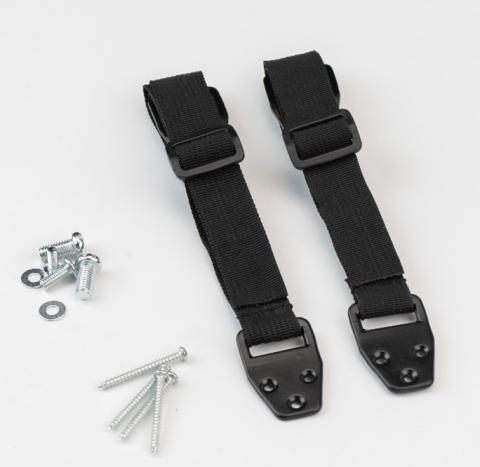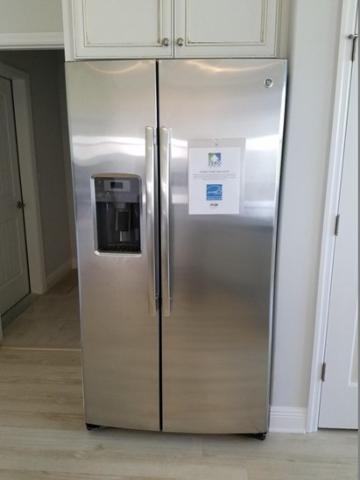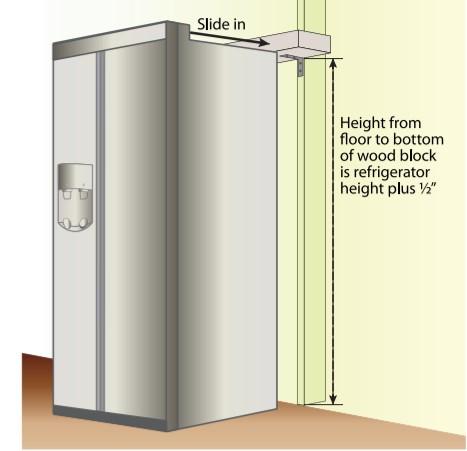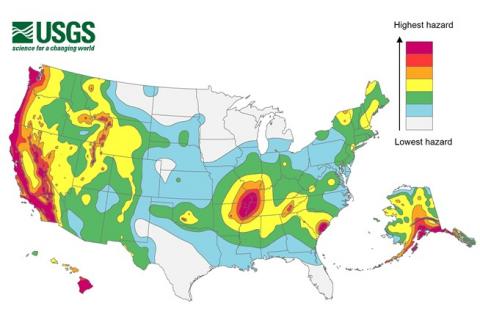Scope
Secure appliances, equipment, and heavy furniture to wall studs and/or floors.
- Anchor or secure
- refrigerators
- dishwashers
- clothes washers and clothes dryers
- water heaters
- furnaces and air handlers
- wood stoves
- freezers
- stoves, ovens, microwave ovens
- electronics, televisions, computers, monitors, stereo equipment
- heavy furniture like bureaus, dressers, and cabinets.
See the Compliance Tab for links to related codes and standards and voluntary federal energy-efficiency program requirements.
Description
Appliances and heavy furniture such as dressers, bookcases, refrigerators, stoves, clothes washers, and clothes dryers can rock, shift, and fall over during an earthquake or other natural disaster. Appliances, equipment, and heavy furniture should be anchored to walls or floors to prevent tip-over during natural disasters as well as for everyday use, especially if small children live in the house. This can be done by a handy homeowner or a contractor.
There is no mandatory federal standard that requires manufacturers to design products and provide installation guidance to prevent tip-over. It is up to homeowners and contractors to be proactive to mitigate tip-over hazards. Figure 1 shows several items around the house that can and should be anchored to prevent appliances from tipping over and other hazards from occurring in an earthquake and other natural disasters.
In the United States from 2000 through 2019, it is estimated there was an annual average of 25,500 injuries treated in emergency departments and 571 deaths due to furniture or appliances tipping over (USCPSC 2021). The STURDY Act (H.R. 1314) “Stop Tip-overs of Unstable, Risky Dressers on Youth Act” was passed in the U.S. House on June 23, 2021, and received in the Senate on June 24, 2021. But even if passed into law, this act will not be inclusive of every type of consumer product and can only govern new products.
Contractors perform a real service to homeowners by providing guidance and modification to secure furniture, appliances and equipment. As described above, toddlers are at risk of injury or death from tip-overs (Figure 1), and in locations prone to earthquakes, tornadoes, hurricanes, or floods, it is even more important to anchor and secure appliances to reduce the risk of damage to the appliances, the home and its contents, and to people (Figure 2).
Furniture and appliances can be anchored to the walls using anti-tip devices designed for this specific purpose. The Consumer Product Safety Commission describes anchoring devices on their Anchor It! website. Homemade versions of anchoring devices can be made using safety cables, chains, or nylon straps with screw-eye fasteners or brackets. There are many commercially available kits that are effective and easy to install. A simple anti-tipping anchor kit using straps and click-together locks is shown in Figure 2. Two recent articles provide reviews and recommendations for commercially available kits: “How to Anchor Furniture to a Wall” published in the Wirecutter blog from the New York Times (2016) and “Furniture Tip-Overs: A Hidden Hazard in Your Home” by Consumer Reports (2018).
All restraints should be connected at the mid-to-upper portion of the furniture or appliance (at or above the center of gravity) to provide the greatest resistance to overturning. The restraining device should be mechanically fastened, not glued, if possible. It should be attached to a strong, solid component of the furniture or appliance side. It should be anchored to a stud in the wall with screws that are long enough to engage at least an inch of the stud.
In addition to tip-over concerns, appliances may have rigid gas or water connections. These should be replaced with flexible connectors, and automatic shut-off valves should be installed for gas and water supply systems. See Home Innovation Research Lab’s ToolBase guides “Retrofit Improvements – Anchorage of Appliances” (Home Innovation Research Labs 2012), “Retrofit Improvements – Elevate & Secure Outdoor HVAC Equipment” (Home Innovation Research Labs 2012), “Retrofit Improvements – Elevate & Secure Water Heater” (Home Innovation Research Labs 2012), and also the BASC guide Automatic Gas Shutoff Valves for more information.
For protection against flood waters, equipment that is located outside or in a basement may need anchors or tie downs to the ground. Or, the equipment may need to be elevated or swales or barriers may need to be installed to divert surface water flows away from the equipment. For more information, see the guides Fuel Tanks Anchored for Disaster Resistance, Water Heater Elevated and Secured, and Outdoor HVAC Equipment Elevated and Secured for Resistance to Floods, Earthquakes, and High Winds.
Whenever dealing with powered appliances, make sure they are unplugged or the circuit breakers are off to prevent electrocution while installing anchoring hardware. Also turn off gas valves at the wall. When re-connecting appliances after modifications, remember to check for firm connections and examine flexible gas piping and collars to confirm there are no leaks.
Below are some examples of appropriate anchoring methods for various appliances.
HVAC Units. In disaster-prone areas, HVAC equipment should be anchored to the floor. If HVAC equipment is located outside, it should be anchored to a solid base to resist seismic forces, floodwaters, and high winds. L-brackets, fasteners, screw eyes, perforated metal strapping tape and other materials used to secure appliances are readily available at hardware stores for under $25 (Home Innovation Research Labs 2012). In areas known to flood, HVAC equipment can be installed on platforms located outside of the home to elevate, support, and anchor the HVAC units (Home Innovation Research Labs 2012). When it is impossible to elevate or relocate appliances in or outside homes located in flood zones, swales, floodwalls, and shields can provide some protection by diverting flow while anchors or tie-downs can prevent the appliances from floating (FEMA P-312 2014). For more information, see the guides Outdoor HVAC Equipment Elevated and Secured for Resistance to Floods, Earthquakes, and High Winds and Water Heater Elevated and Secured.
Refrigerators. Built-in refrigerators usually come with brackets and instructions for anti-tilt installation (Home Innovation Research Labs 2012). Cabinets and shelves secured above the refrigerator with no more than a 2-inch gap can also serve as an anti-tilt block or blocking can be installed above the refrigerator to prevent tipping as shown in Figure 3.
How to Install Tip-Preventing Blocking for Refrigerators
- Cut a 2x6-inch wood block the same width as the refrigerator and secure L-brackets to the 2x6 using #12 or #14 wood screws.
- Secure the L-bracket to the wall behind the refrigerator so that it is ½-inch higher than the refrigerator (Figure 4). Use #12 or #14 wood screws. Screws must penetrate at least 1 inch into vertical wall studs.
- Slide the refrigerator into the space below the lumber.
- Place excess slack in the power cord on top of the refrigerator and make sure the power cord is not pinched behind the refrigerator unit.
- The refrigerator could also be attached to wall studs with an L-bracket attached directly to the refrigerator; however, this may cause damage to the unit.
Ranges and Ovens. Most ranges are shipped with anti-tip brackets that prevent both tip-over due to children climbing and shifting in the event of an earthquake. These should be installed at the time of purchase. For aftermarket solutions, search by product manufacturer name or for generic equipment that performs the same function. Prices vary greatly, from as little as $3 per generic bracket up to $25 for a genuine branded replacement part set. These may mount to the wall and snap into the rear of the range or screw to the floor to hold the appliance’s feet in place. Anti-tip brackets can be tested by opening the oven door and pushing down on it (Home Innovation Research Labs 2012). A door locking mechanism (Figure 5) can protect children from being “clammed” between the oven door and appliance body (U.S. CPSC) but does not stabilize the appliance in the event of a flood or earthquake.

Dishwashers. Under-counter dishwashers are usually attached to the counter with L-brackets to prevent the entire unit from tipping forward (Home Innovation Research Labs 2012). Dishwashers should be inspected to make sure that they are secured to the counter, and the counter should be secured to the base cabinets, and the base cabinets should be secured to wall framing. When not in use, portable dishwashers should be stored in a location where a bracket or anti-tip shelf can prevent tip-over using principles similar to solutions for refrigerators (above).
Clothes Washers. Top-loading clothes washers can be secured to the wall with heavy-duty brackets and cables similar to those described above. Make sure the product is rated for the expected force, which could be several hundred pounds with a full tub of water and clothing. Alternatively, perforated metal strapping tape or cables that are attached to the wall with heavy-duty eyehooks screwed into wall studs on either side of the appliance also work. Front-loading machines can be secured to the wall or floor with brackets similar to those available for free-standing ranges (see above) or more general hardware solutions such as L-brackets mounted to wall studs and/or the subfloor.
TVs & Other Small Electronics. Earthquake movements and the winds associated with hurricanes and tornadoes can cause electronics resting on shelves or counter tops to fall and break. These electronics can be secured with flexible nylon straps and buckles for easy removal and relocation (Figure 6). Small electronics and countertop kitchen appliances can become deadly projectiles in an earthquake. Move heavy items and breakables to lower shelves. Use either hook and loop fasteners on the countertop and object, or non-damaging adhesives such as earthquake putty, clear quake gel, or microcrystalline wax to secure small appliances, electronics, and other breakables in place on tabletops, countertops, or shelves. Leash locks or strap and lock fasteners can be used for equipment that is occasionally moved like mixers, toaster ovens, and other kitchen countertop appliances or stereo equipment (Earthquake Country Alliance 2020).
VESA mounting systems can be used to securely attach a flat-screen television to the wall (Figure 7) (Earthquake Country Alliance 2020). VESA is a standard used for TV wall-mounting systems that has been adopted by most TV brands. VESA (Video Electronics Standards Association) is a professional organization made up of video electronics professionals who develop standards to promote uniformity in the video electronics industry. The VESA Interface Standard defines the distance in millimeters between the four mounting holes on the back of a TV (distance measured horizontally by distance measured vertically). Hole distances range from 75 x 75 mm to 800 x 600 mm but common VESA sizes for flat-screen televisions are 200 x 200, 400 x 400, and 600 x 400 depending on the screen size of your TV. To determine the VESA size for a TV, you can refer to the specifications in the product manual or simply measure it by locating the four holes on the back of the TV and measuring with a millimeter ruler first left to right between the top two holes then top to bottom from either top hole down to the hole below. When mounting the bracket to the wall, install the screws into studs. Or, install pieces of 1x4 lumber horizontally that attach to at least two studs on the wall behind the flat-screen TV where the screws will be located and screw the VESA mount to the 1x4s.
Furniture and Bookcases. Large pieces of furniture such as tall bookcases and file cabinets can topple in the event of an earthquake or pose a tip-over hazard for small children. Anchoring furniture can prevent injuries as well as protect the furniture itself (FEMA 2008). Make sure that all anchoring screws penetrate not just the wall but the studs behind it as well. Screws embedded only in drywall or plaster will pull out. Regardless of the anchoring method, screws should be long enough to extend at least 2 inches into the wall and wall studs (FEMA 2008). When anchoring a bookcase to the wall, use L brackets that are screwed into wall studs and into sturdy parts of the shelving unit such as the top or sides (Figure 8). Use the bracket provided with the shelf, or after-market furniture anchors are available. Do not attach brackets or anchoring screws to the bookcase backing, which is often thin paneling or pressboard that is not a structural part of the shelving unit. Many file cabinets come with lockable and self-latching drawers. If installing file cabinets without self-latching drawers, add latches. Two or more bookcases or file cabinets that sit next to each other should be connected to each other as well to the wall (FEMA 2008). Make sure framed art and mirrors are securely attached to walls; consider using hook-and-loop or adhesive fasteners in addition to wire hangers to prevent frames from swinging or banging against walls during seismic events. Do not hang heavy art on the walls above beds or cribs. Choose chandeliers and light fixtures that have all components (glass globes around individual lights, etc.) mechanically attached, not just sitting in place, and ensure the fixtures are securely attached; reinforce hanging wires or cables if necessary.
Success
Visually inspect the home after all appliances and fixtures have been installed to ensure all tall and heavy items are secured and anchored. Encourage the homeowner to inspect the home after move-in or replacement of furniture and appliances to ensure all such objects are anchored to wall studs; all pictures, mirrors, and light fixtures are securely fastened; and movable appliances and electronics are anchored and/or located on lower shelves.
Climate
Reference the seismic map below to see if your home’s location is prone to hazards from seismic activities.
Training
Compliance
Compliance
International Mechanical Code (IMC)
American Home Furnishings Alliance (AHFA)
Consumer Product Safety Commission (CPSC) Standard for Clothing Storage Units
Underwriters Laboratories Inc. (UL) Standard for Household Electric Ranges (UL 858)
American National Standards Institute (ANSI) Standard for Household Indoor Cooking Gas Appliances (ANSI Z21.1)
Retrofit
The information provided in this guide applies equally to new and existing homes.
More
More Info.
Access to some references may require purchase from the publisher. While we continually update our database, links may have changed since posting. Please contact our webmaster if you find broken links.









